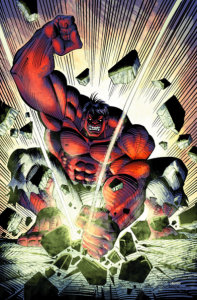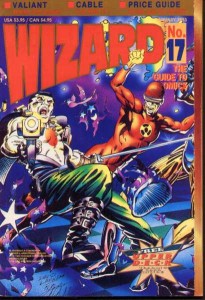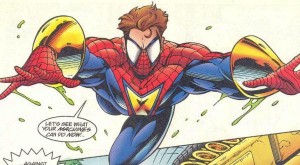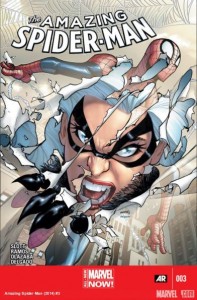Maths and Charity
by Nevs Coleman 12-Jul-14
Nevs Coleman’s new column looks at the economic realities of comics fandom.
(Thanks muchly to various friends on social media who kicked in with research and comments, including a few people who probably wouldn’t if they knew what I was up to.)
One of the things I’m quite proud of getting into the conversation on the price of comics is the idea of “Nevs’ Netflix Test”. The concept is simply this: “Does your comic cost as much as a month’s subscription to Netflix, and if so, do you honestly think it’s worth that much?” Someone who seems to have taken that on board is a chap who messaged Tom Breevort on one of the latter’s frequent Q& A sessions. (Which are found here. He’s usually fairly reasonable, although he’s stopped answering my questions since I suggested to him that most Howard The Duck fans only really wanted to see Gerber write him and getting anyone else to do is like getting anyone else to draw and write Calvin & Hobbes. He tends to start posting images of Sal Buscema art when I show up.)
The following is copied and pasted with no edits from myself from one of those Tom Breevort frequent Q & A sessions:
“$4.99 is too much.
“Tom, I love Marvel comics. Marvel brought me back to comics reading in a big way after the Avengers movie, and I’ve spent a lot of money on comics since but $4.99 for a single issue is too much. In September, you have 15 books coming out at the $4.99 price point, including several titles which I have been following from the start (Hickman’s Avengers books, Spider-Man, etc). If I want to keep reading the series I’ve been following, I have no choice but to buy the bloated $5 issues that month. Had Avengers/New Avengers been $5 an issue when Hickman’s run started I would not have bought any of it. Remember when it started, Hickman’s New Avengers was a $2.99 book? Those were the good old days.
“I am currently paying ~$8 a month to read Amazing Spider-Man, which is almost as much as my Netflix subscription. Do you think I get comparable value for my money? What if Amazing were $5 per issue and I was paying $10 a month to read it. At $10 a month, its cheaper to get Marvel Unlimited and you get everything else that Marvel publishes, just a little late. How does this make sense?”
You know what I’m going to say here, more or less. The books cost what they cost.
In the cast of those assorted $4.99 titles, they’re all larger-than-normal issues, which are typically priced higher. They need to be, in order to accommodate the greater story length. These books won’t cost that much on a regular basis.
I’m not unsympathetic to the dilemma that you’re facing. As somebody who goes to the comic shop every week, I face it myself. But it always comes down to the same fundamental underlying question: are you interested enough in or invested enough in a particular title to continue to purchase it? That’s a choice that you make every month, every issue. And it’s our job to try to keep you in your seat, by making our stories as compelling as we can.
But I can’t make this stuff cost less. The cost of everything continues to rise, inexorably, as it always has.
I’ll probably never stop coming back to the formation of Image Comics as the catalyst of everything altering in comics entirely. For me, its like the Kennedy Assassination or Altamont as a pivotal moment in history that can be pinpointed as the start of everything changing so dramatically, and the only other thing I can think of as being so effecting is the beginning of the direct market. One day I’ll actually sit down and write down what I think of The Image Revolution’film, as it’s such a… skewed look at history. (If nothing else, there’s literally no mention of Wizard Magazine or its effect on the comics industry in the ′90s, which is one heck of an omission.)
In this context, it’s probably fair to simply sum up Image as a company that nobody “in the know” took very seriously until those sales records were broken by ex-Marvel talent on a regular basis. That crack in the market gave other publishers ideas of launching their own lines of superhero comics, in what was an incredibly profitable period for the business, and by 1993, Dark Horse, Malibu, Continuity, Topps and more all had about five or six new titles filling up the shelves, all with the “subtle” suggestion (again, see both Wizard and also ads from American Entertainment) that buying these comics would be a worthy investment. The sheer volume of those titles filling up 5 for £1 boxes in shows or dumped in various charity shops across the country tells you how wise an idea that was.
Fast forward a couple of years, and everything has bust quite badly. Many books simply haven’t shipped, readers have had time to see through the hype and the big sales on various #1s haven’t translated to long-term sales. Shops that would order fifty copies of Fatale 1 would be hard pushed to convince themselves to order five of #6. The amount of actual brick & mortar shops had also decreased due to going under under harsh economic realites. Everything is contracting.
And out of nowhere, Marvel buy Malibu.
I’ve heard a couple of versions of just why Marvel did this, as it doesn’t really make a lot of sense for them to do so. Marvel weren’t doing that well at that period, Malibu had lost Image as Lee, Liefeld & Co decided they didn’t need Malibu to publish their books and the Ultraverse had long since lost its initial spark of interest.
It’s… fairly safe to assume that Marvel weren’t really that interested in the likes of Prime, Hardcase, Mantra and such, given how little effort was put into those titles upon acquisition. The idea I’ve heard most is that Marvel told everyone that they wanted Malibu’s colouring team (which to be fair was far better than the obsolete system they were using at the time), but actually just swooped in on DC’s original proposal to pick up the company to fuck up DC’s plans. DC were incredibly, and rightly, worried about the possibility of losing their previously unshaken place as the number 2 publisher of comics, thanks to Image’s high sales. Hence their desire to purchase Malibu and secure their position. I imagine their having the regular books, Vertigo, Bravura and the Ultraverse would have helped do that. Oddly, Marvel appear to legally constrained for talking about the deal with Malibu and aren’t able to do anything with those properties at all.
Meanwhile, having acquired Malibu, Marvel were facing criticism for the general state of their books compared to Image’s output. Image were using high quality paper stock and digital colouring whilst Marvel used the same low quality paper and four-colour process that they’d been using for years. Exploiting the resource of Malibu, for a brief time they presented both customers and retailers with two options: they could have the standard edition for the regular price of $1.50, printed on newsprint; or they could have the Deluxe edition for $1.95, printed on glossy paper. Sounds fair, right? Take your pick. Not Marvel’s fault the fans chose the price hike, and retailers ordered so low on the newsstand versions that it wasn’t worth Marvel printing them anymore.
Well, yes, except for one thing I omitted to tell you.
Sure, you could totally, absolutely go for the cheaper edition if you wanted. That was certainly an option that was possible. Except you had to wait two weeks later for shops to receive the newsprint editions in the first place. That’s right. Marvel rigged the customer choice of format, knowing full well that if they put out the deluxe version first, that would be what sold first and fastest. That act broke the seal on the price hold that had been in place for years. It didn’t take that long for price-hike justifications along the lines of “Well, we’re using glossier paper and that costs a little more than we expected, but hey, that was the decision you guys made.”
We went from $0.95 to $1.99 to $2.25 to $2.50 to $2.99 in a very short space of time. It doesn’t seem that long ago that we were astounded that Marvel would dare to charge $3:99 for a regular comic. We were assured back then that this price point would only be reserved for special occasion titles, but I’m hard pushed to think of a dozen comics from their output that cost less than $4 today. And that ascent all started with Marvel buying Malibu.
It’s easy to write off this frankly ridiculous price hike as simple inflation, the cost of printing against an ever-diminishing audience despite comic franchises being literally more in the public eye on a regular basis than any other point in history. Some might even argue that considering just how much exposure the likes of Cap, Spidey, Wolverine, Thor and the X-Men get on a regular basis thanks to Disney, Sony, Fox, Netflix and Lego, these comics really ought to be doing a hell of a lot better than they are.
Tom’s oft-repeated stance when questioned on the price of Marvel Comics is that they’re “not a charity” and that’s absolutely right. They’re a capitalistic entertainment venture. The problem with that hardball stance is that it doesn’t really hold up when compared to other entertainment mediums. To be honest, the patience and indulgence of Marvel’s customer base could be considered charitable when you consider the following.
Comics are just another entertainment vehicle. They’re no more noble or, honestly, literate than film, books or video games. There isn’t any special fund dispensed to comics readers to maintain their habit, and if I was someone who had to pay actual money for the majority of my new comics, I’d have given up on most of them a long time ago. I’ll pay $15 for the new volume of Love & Rockets on a yearly basis. I’m not inclined to do so every week to catch up with any Marvel book since I can almost take it for granted that anything of note will be rewritten within three years or less, and The Outhousers running joke “The Temporary Hiatus Of Wolverine” is a fine testament to that fact.
So if we’re going to play the hardcore line that Marvel is going to charge what it does and it’s not their problem if you feel you can’t afford to pay their prices anymore, then it is surely fair to point out that Marvel is in competition with everything else out there and to point how much they’ve totally ignored the rate of inflation with their unit price. To do a fair comparison, I pulled out an issue of Amazing Spider-Man from 1994, and one from 2014. In both instances, I picked a regular, non-event, non-anniversary, non-crossover bookend, or any other convolution that would denote a price hike for that circumstance.
Amazing Spider-Man (Vol. 1) 387. Published: 199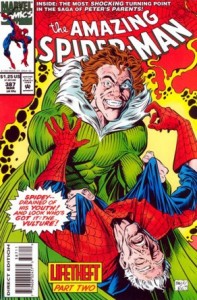 4. Price at publication: $1.25.
4. Price at publication: $1.25.
Amazing Spider-Man (Vol. 3) 3. Published : 2014. Price at publication: $3.99.
Between 1994 and 2014, that’s a price hike of over 200% per unit. Compared to say:
Price of a cinema ticket in 1994: $4.08.
Price of a cinema ticket in 2014: $8-$13.
Price of a new Stephen King paperback in 1994: $5:99.
Price of a new Stephen King paperback in 2014: $10.
Price of a new video game in 1994: $60.
Price of a new video game in 2014: $60.
(Figures courtesy of friends and Wikianswers.)
In every comparison here, in all comics’ natural competition, no other unit (except the top end of cinema tickets) has risen more than 100% over that period of time. Sure, the video game world is fraught with pre-order bonuses items and Beta access privileges for paying out more, but if they’d be subject to the same price increases that comics are, you’d be looking at a base unit cost of nearly $200 for a copy of Far Cry 4 this Christmas.
Sure, that’s probably an unfair comparison. After all, comics have to deal with rising paper costs, a diminishing audience, all kinds of reasons why you won’t be able to get three Marvel Comics for $10 by Christmas 2015, but the fact is, I can buy Amazing Spider-Man 1 for $8 or get a second-hand copy of Saints Row The Third on PS3 for $6, and I know which one will provide more entertainment for my money.
That’s sad for Marvel that they have to charge that much, but it is what it is. And I’m not a charity, either.
Tags: Marvel